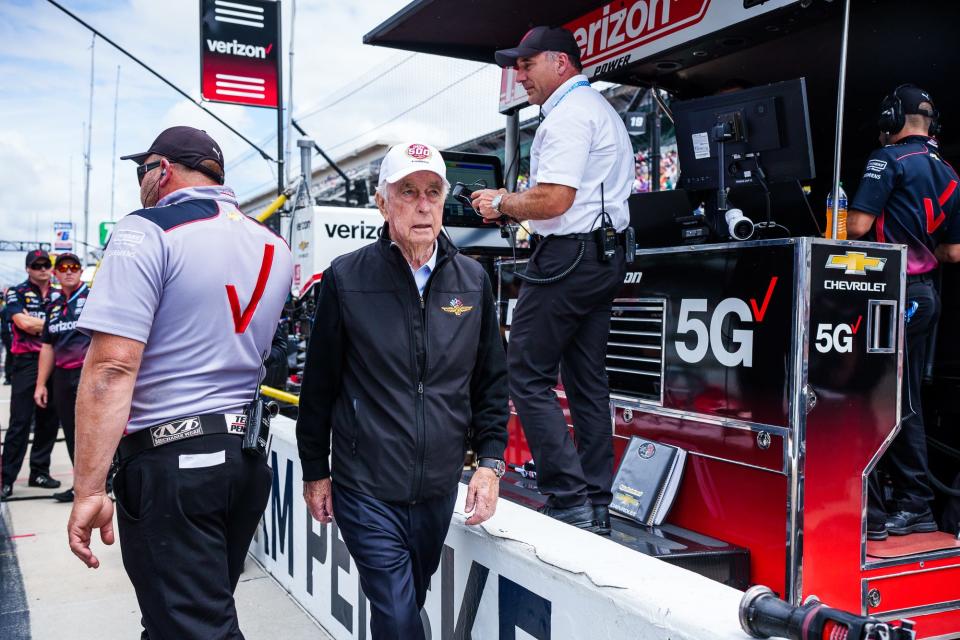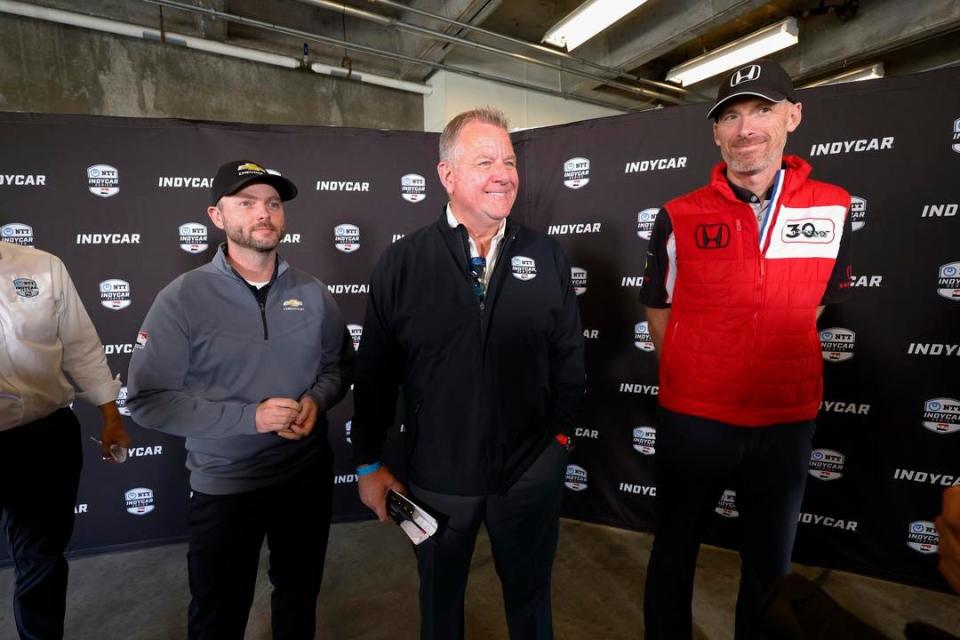Insider: IndyCar's recent setbacks raise questions about series' future
In Roger Penske's introductory press conference as the owner of IndyCar (and IMS), The Captain was asked about his vision for changes to the American open-wheel racing series.
Penske had one priority: The third engine manufacturer the series has sought since Lotus’ sloppy, short-lived exit more than a decade ago.
More than four years later, if recent quotes from American Honda Motorsports manager Chuck Schifsky to RACER are not just public posturing, Penske Entertainment could be closer to becoming a single-make series than landing a third. Schifsky characterized Honda’s eight-figure investment in outfitting more than half the series’ 27 cars too expensive when compared to the exposure it gets and the kind of innovation it can explore under present-day rules.
Drastically change your cost-structure – i.e., land that third engine manufacturer the paddock was all but promised four years ago or slash expenses that skyrocketed this year when Honda and Chevy were tasked with pushing IndyCar's stalled hybrid project to the finish line – or risk losing a 30-year partner when the contract expires at the end of 2026, the Honda executive said. And do it within the next 12 months.
"We don’t have a third manufacturer and there’s a reason for that: It has to do with the cost. If the return on investment matched up with the investment, we’d have a number of other manufacturers involved," said Schifsky, who pointed to IMSA and Formula 1, series' where costs for an OEM per entry are far greater, but where opportunities for technological advancement and present-day buzz dwarfs IndyCar's soon-to-be 13-year-old car and engine package. IndyCar officials would argue that updates (like the aeroscreen, body kit and safety features) make it just as much a new car, but its Frankenstein characteristics, with loads of bolted on parts that weigh it down, are hard to ignore.
“We’re looking for a wholesale change to the engine regulations so that we can eliminate fives and tens of millions of dollars of annual technical costs,” Schifsky continued. “Because if we don’t, then it’s too much money, and we will go do something else."
IndyCar won't address the situation publicly but officials privately pointed to what they say is a lengthy timeline to rectify Honda's concerns. One noted that Penske Entertainment is always cognizant of costs for its teams and manufacturers. That reassurance comes at a time where Honda and Chevy were leaned on heavily to finish the hybrid project, and IndyCar teams saw their cut of their Leaders Circle payments trimmed by $100,000 per car last year to help fund the series' marketing efforts.
Those sounds you hear is the grumbling and whispering behind the scenes of a growing number of frustrated teams and drivers lamenting IndyCar’s series of fumbled opportunities, setbacks, misunderstood decisions or gambles that have culminated in Honda’s ultimatum.
It’s pertinent to note these various shortcomings and disappointments haven't been entirely the series leadership’s doing; but they’ve come on their watch and they’re starting to pile up.

2023 IndyCar season showed solid growth, but...
Mind you, just last season, IndyCar saw sizable growth in its average TV audience, an increased interest in more ‘hip’ and relevant merchandise offerings and notable growth in ticket sales. Its major partners – NBC, NTT, Gainbridge, Chevy and Honda – have all had their existing deals renewed at least once under the series’ new ownership. In a digital age, its social media footprint spiked in quantity and quality, and the series invested millions of dollars to get its biggest names in front of more eyeballs via commercials and public appearances.
Within the paddock, the stability of Penske leadership has attracted a recent influx of European talent that had all, in their own ways, stalled on the Formula 1 track across the pond. Down the ladder of American open-wheel racing, Penske’s aura has helped transform Indy NXT (formerly Indy Lights, the final step in the Road to Indy) from a grid of eight full-time cars (2019) to more than 20 this spring.
At the IndyCar level, teams and partners from McLaren, Meyer Shank Racing, Juncos Hollinger Racing and HMD Motorsports, have either grown their involvement, returned to the series or joined it for the first time. And with that, the full-time grid has five more entries since the fall of 2019. It’s no hyperbole to say IndyCar holds its strongest foundation, from team health to driver talent depth and general paddock-wide stability, in its modern-day era.
Talk to any number IndyCar or Penske Entertainment executives about the state of the sport, and they’ll quickly point to that concrete entry growth that has come from that burgeoned stability.
Oh, and you’ll hear about ‘on-track passes.’ They love on-track passes.
There are other positives too, between a return of legitimate night racing next year, a soon-to-be-formalized second season of ‘100 Days to Indy’ and the potential that lies in racing in the true heart of cities like Nashville and Detroit. But none of that is overly novel, new or out-of-the-box as much as they like to claim it to be.
From 2021: Miles says Penske's purchase saved IndyCar, IMS from a 'challenging' future

Major setbacks becoming a trend in recent months
Texas Motor Speedway, the series’ longest-standing continuous host track not named IMS, fell off next year’s schedule this fall.
Two months later, IndyCar’s next console video game, announced in 2021 for a 2023 debut after more than a decade of absence in the mainstream gaming space, officially sputtered in the hands of an ill-equipped, under-funded company (Motorsport Games) that didn't fall into disarray overnight.
And just last week, the latest crater in the road: Series leadership first announced plans for a new engine in 2018, to replace the current package that debuted in 2012. When we reach St. Pete this March, nearly six years after that initial announcement, the project will have been twice transformed and thrice delayed, still with an unknown rollout date that’s targeted sometime this summer.
More engine woes: IndyCar delays 10-team hybrid test, new engine to debut mid-2024
Alone, none of those letdowns represent more than a bleak mark on an otherwise solid year for the growing sport. Together, though, they paint a picture of shortcomings in three foundational pillars key in motorsports at the moment: continuity in one's schedule, off-track shoulder programming and timely technological innovation.
When you also consider series leadership is staunchly against the refresh of a new car, while thinking a new OEM will show interest once the new hybrid debuts (after they all declined the competitive advantage to get in on the ground floor), you can start to see the root of Honda's displeasure in the status quo.
Because it presently leaves one major question unanswered:

Where is this sport going if some of its major tentpoles and long-awaited projects have become tougher and tougher to achieve?
Leadership would have you know it’s constantly working, moving and shaking in the background, while it juggles putting out fires and casting a vision for its future, but what does the future look like with that approach?
Is it risking putting faith in partners like MSG and Mahle that overpromise and under-deliver? Is it being late to the shoulder programming game, and then rolling out a sometimes choppy and stilted six-part Season 1 on a little-watched, brand-new network partner? And does its risk-taking look cutting edge and forward-thinking, or does it simply lead to more questions, complaints and PR fires to put out, like the notoriously high-priced All-Star event at Thermal?
More expensive than F1 in Vegas: Attending $1 Million Challenge at Thermal will cost you thousands
These are but a sampling of questions and concerns – there are, no doubt, others – felt across a paddock that once couldn’t speak highly enough about a bright, promising future under Penske leadership. Nowadays, it includes growing factions of veteran voices among drivers, owners, team officials and fans questioning its priorities, connectivity to its base and effectiveness in ensuring that major, impactful projects land on-time and as-promised.
Some believe the series feels stale with its soon-to-be 13-year-old chassis, its eventual hybrid engine and its inclination to try and revive old events (see Iowa and Milwaukee) that had previously fallen off the calendar. It’s become more and more reasonable to see the series as a continuous ‘follower,’ from its protracted jump to hybrids a decade after F1 and more than a year after IMSA, to its push to race on Broadway in Nashville only after NASCAR took to the streets of Chicago and F1 roared down Vegas’s Strip.
It's not what those who make their living in the sport, or who control seven or eight-figure expense accounts within the sport, were promised four years ago. Pandemic or not, maybe those visions of grandeur painted by many – me included – were unfair. And just two years removed from the end of COVID-19’s hold on the sport, there is still more runway with which to rebound. It’s important to remember that Liberty Media didn’t seem to reap the benefits of its purchase and infusion of funding, energy and change in F1 for four or five years.
But the clock is ticking, and the slate is no longer blemish-free. Though IndyCar may not be at risk of dying and disappearing, a fall into obscurity, stagnation and false-starts could be only marginally better.
This article originally appeared on Indianapolis Star: IndyCar: Setbacks with video game, hybrid raise questions about future growth
